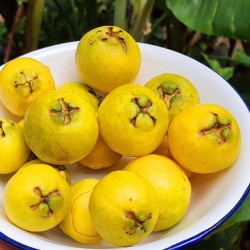- -15%
- New

Plant resistant to cold and frost

Coming Soon









Fruit Description: Appearing in late Summer, they are small red fruit, very tasty, when ripe. Usually eaten fresh or used to flavor beverages, ice creams, desserts and jams. Strawberry guavas taste like a passionfruit mixed with strawberry. The skin is also
Fruit Description: Appearing in late Summer, they are small red fruit, very tasty, when ripe. Usually eaten fresh or used to flavor beverages, ice creams, desserts and jams. Strawberry guavas taste like a passionfruit mixed with strawberry. The skin is also edible and tastes a bit like rose petals but is best removed for a sweeter flavour. The seeds are small and white in colour and can be roasted as a substitute for coffee.
Growth tips: Fast grower, fast to fruit, provide ample nutrition and water.
Usage: This plant is attractive to bees, butterflies and/or birds. Suitable for growing indoors
Aditional information: Psidium cattleianum is closely related to common guava (P. guajava), but can survive under lopwer temperatures. This plant is attractive to bees, butterflies and/or birds.
Wikipedia:
Psidium cattleianum,[1][2] named in honour of notable English horticulturist Sir William Cattley, commonly known as Cattley guava or Peruvian guava, is a small tree (2–6 m tall), bearing small red or yellow fruit, which are somewhat sour but sometimes eaten or made into jam. The red-fruited variety is known as strawberry guava; the yellow-fruited variety is known as lemon guava, and in Hawaii as waiawī. Native to Brazil and adjacent tropical South America, it is closely related to common guava (P. guajava), and like that species is a widespread, highly invasive species in tropical areas, especially Hawaiʻi. It tends to form dense, monotypic stands which prevent regrowth of native species, and is very difficult to eradicate; it also provides refuge for fruit flies which cause extensive agricultural damage.[3] As an invasive species, it is sometimes erroneously called Chinese guava.
The fruit can be eaten whole as both the thin skin and soft, juicy interior are edible. Strawberry guavas taste like a passionfruit mixed with strawberry; lemon guavas have a more acidic and spicier flavour. The skin is also edible and tastes a bit like rose petals but is often removed for a sweeter flavour. The seeds are small and white in colour and can be roasted as a substitute for coffee. Its leaves may be brewed for tea.
|
Sowing Instructions |
|
|
Propagation: |
Seeds |
|
Pretreat: |
soak in water for 12-24 hours |
|
Stratification: |
0 |
|
Sowing Time: |
all year round |
|
Sowing Depth: |
0,5 cm |
|
Sowing Mix: |
Coir or sowing mix + sand or perlite |
|
Germination temperature: |
18-25°C |
|
Location: |
bright + keep constantly moist not wet |
|
Germination Time: |
10 - 45 days |
|
Watering: |
Water regularly during the growing season |
|
|
|
Data sheet